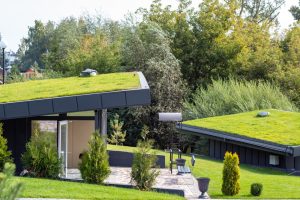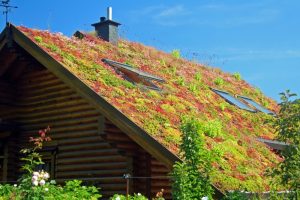Green Roof Installers in Cedar Park


Our team has provided exceptional roofing installation and repair services throughout Texas and Colorado for the past four decades. As innovation changes how we build, Kidd Roofing stays ahead of the curve to give you durable, sustainable, and economical solutions.
Contact us online or by phone at (866) 671-7791 to speak with one of our consultants.
What Is a Green Roof?
To be considered “living,” a roof must incorporate plant growth. Green roofs, in their simplest form, could use seed grass, sod, or moss. Provided the roof and your building can support the additional weight and depth, you may be able to grow wildflowers or small trees.
Green roofs are diverse in form and function, but they boil down to two basic types:
- Extensive roofs – Extensive roofs are light and straightforward, supporting a comfortable amount of plant matter while not requiring too much maintenance. Sod and moss are the most common plants used due to a thinner soil depth, and they’ll expand their reach over time to give your building’s façade extra whimsy.
- Intensive roofs – Intensive roofs have a deeper layer of soil to support flowering plants, trees, and other vegetation. While you may need an irrigation system or gardening staff to tend to an intensive roof, you’ll also have more creative license. Many intensive roofing projects add value through walking paths, wildlife habitats, urban farms, or other recreational spaces.
Components of a Green Roof
Green roofs begin with a corrugated membrane made from composites, rubber, or metal. This membrane keeps water from entering the facility and prevents roots from growing into your structure. An additional layer may allow excess rainwater to leave the environment through your drainage system.
The growth medium your roof uses will depend on the type of vegetation you’ll plant. You could use mineral wool or a thin layer of compost for grass or moss. Intensive roofs will use a deep layer of standard soil, which you’ll reinforce with occasional fertilizing.
As a rule of thumb, the higher your roof’s slope, the fewer layers it may need to stay waterproof. On pitched roofs, excess water beyond what the growth medium can absorb might run down the side. Flat roofs could require thicker layers or a robust drainage system.
History of Green and Living Roofs


The technology didn’t stray too far from Scandinavia until the 1960s and ’70s. Facing an energy crisis, West German designers resurrected green roofing as an innovative conservation tool. The populace took to these roofs, which became an aesthetic, practical feature in modern residential neighborhoods and burgeoning town squares. Other European countries followed suit, establishing research institutes and urban planning initiatives to further refine the technology. Today, some jurisdictions in the U.S. have incentive programs or even regulatory requirements promoting living roof adoption.
Benefits of Using a Green Roof
The benefits you’ll reap from a green roof differ depending on the design and type you use. A few of the shared advantages include the following:
- Energy efficiency – Plants provide a robust layer of insulation against heat and cold, saving you money and energy you’d otherwise consume with an HVAC system. Used en masse, they can mitigate or remove heat islands for entire urban districts.
- Water management – Green roofs are powerful tools for managing water runoff. Rainfall on your roof feeds the plants, and the excess can evaporate into the atmosphere. Since there’s decreased stress on sewer systems or storm drains, the water in the surrounding area stays cleaner for longer.
- Carbon capture – Plants in a green roof filter carbon from the air, significantly lowering your property’s emissions.
- Wildlife protection – A living roof attracts birds and pollinators to urban areas, preserving their habitat.
- Longer lifespan – UV light, wind, and rapid temperature changes can wear down a conventional roof over time. Green roofs’ nature gives them a longer lifespan. The plants get food through photosynthesis, and your roof could last two to three times as long.
Considerations When Installing Green Roofs
Like any other roofing system, green roofs have their advantages and disadvantages. Before deciding to install a green roof, you should take these considerations into account:
- Required systems – If you choose an intensive green roof, you may need to invest in irrigation and drainage infrastructure to keep the plant life healthy, adding cost and weight to your project.
- Weight – The thicker your layer of soil, the more water your roof will hold and the more weight it adds to your structure. For green roof retrofit projects, a contractor should consider the maximum static load your building can take.
- Staffing requirements – If you incorporate recreation into a commercial green roof, you may need to hire gardeners to tend to the vegetation. Left ignored, pests could eat away at the plants, negating the benefits you enjoy.
Technology is constantly improving, and many of our customers receive a tailored green roof solution that’s low maintenance and maintains good integrity over time.
Contact a Cedar Park Green Roofer
If you’re considering installing a green roof for your Cedar Park, TX, home or business, trust the Cedar Park roofing specialists of Kidd Roofing to guide you through your options.
The Kidd Roofing team is ready to answer your questions about green roofs and design the perfect solution for your home or business, whether you’re building anew or seeking to optimize your existing building’s sustainability.
Contact us at (866) 671-7791 to get a quote and start planning your project today.
Related posts:








